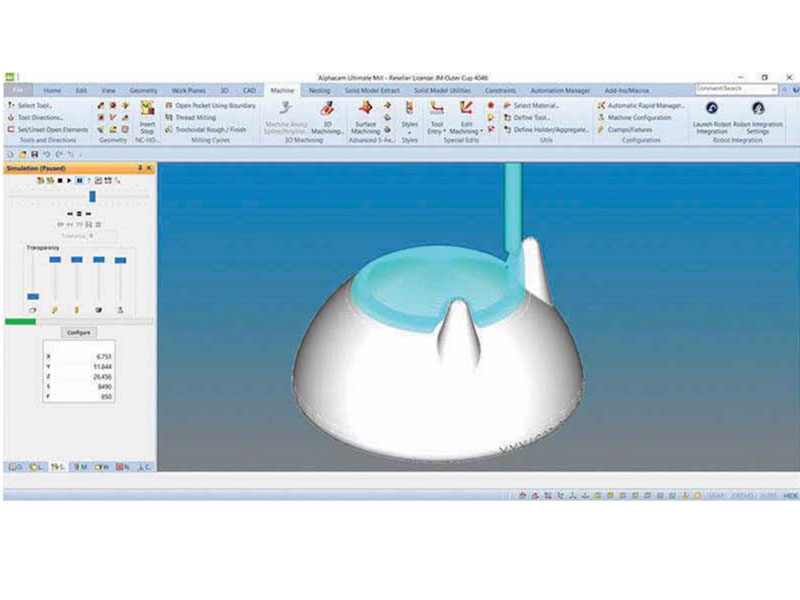Jointmedica Ltd., based in Worcestershire, UK, produces Class 3 implants in the orthopedic sector, and has, in its product portfolio, an innovative mobile-bearing Knee Replacement, as well as development activities relating to Hip Resurfacing and the manufacture of custom-made devices for specific patients created directly from CT scans.
Development is done in-house!
The high-level development activities can now be undertaken in-house at Jointmedica’s facility in Hallow, utilising ALPHACAM’s computer-aided machining software. As well as allowing them to take advantage of the brain trust and Intellectual Property available via the company’s founder, Prof Derek McMinn, ALPHACAM assists the design team to further explore these innovative new designs and incorporate new materials driving the advancement of Orthopaedic Hip and Knee Replacement surgery, therefore exacting controls, and the highest quality, is paramount.
Technical Director, Roger Ashton, says: “If we consider the Hip Resurfacing market in isolation, several years after the procedure began, a small number of patients suffered physiological problems due to hypersensitivity to various metals. The end result was that a small percentage had bearing related failures. This led to a sharp decline in the use of metal-on-metal articulations in the Resurfacing context. It is Jointmedica’s purpose to work with alternative bearing materials such as ultra-high molecular weight polyethylene, using the successful Resurfacing methodology to generate a product that will re-establish the Hip Resurfacing market. In terms of our surgeon team, we are privileged in being associated with the most experienced Hip Resurfacing designers and surgical innovators in the world.”
When the company brought their manufacturing research and development in-house, the need for investing in a suitable machine and CAD/CAM software became apparent. Roger says: “It was clear we were going to have an interesting combination of 2D turned profiles and surface machining with milling, drilling, and slotting, and we were conscious that we had a lot of complex geometries to deal with. So, we needed a CNC machine tool and software that could manage all of our milling and turning requirements, including sometimes more than 3-axis.” And, he says, their Brother Speedio M140x2 full 5-axis CNC machining centre fit the bill perfectly. “Many products require a combination of 3-axis and 4-axis machining, plus turning operations. So ALPHACAM will always be an integral part of our manufacturing process now.”
Customizing implants
Generating custom implants at Jointmedica begins the moment they receive the patient’s CT scan, which allows them to start modelling the bespoke product. They use two CAD systems to design the solid models – mainly Creo, and occasionally SolidWorks. The files are usually sent as an XT file, STEP file, or as a DXF file for the turning cycle in the lathe software.
The company uses ALPHACAM Ultimate Mill and Standard Lathe to machine the finished product with the Brother capable of both turning and milling. Oliver Clayton, Manufacturing Engineer at Jointmedica, explains: “I take ALPHACAM’s 3+2 system and incorporate it into some of the bespoke custom devices, and then, an easier 3-axis and turning program definition on the cutting paths for a simpler, axisymmetric product. In the turning program, I mainly use the CAD side in drawing the geometry and applying the toolpath. That’s extremely useful because I can incorporate not only the model but draw my own toolpaths in there with the geometry.”
As an example, the materials for a ball and socket type of bearing, which work well when implanted in the body as a Hip Replacement, can include ultra-high molecular weight polyethylene of differing formulas, and a counterface of cobalt chrome, ceramic, or other material.

“Through accurate machining driven by ALPHACAM, material wastage is kept to a minimum, and we can also ensure the final, bespoke product is suitable for the patient,” Oliver says it’s of the utmost importance that the implants are of the highest precision. “When we come to CMM measurements they must be dimensionally correct, and ALPHACAM ensures we get the right results every time. When considering our prototyping expectations, we are comfortably achieving the industry expected tolerances and a bearing surface finish of 0.8 Roughness Average for one-offs. We know that future production capability will significantly exceed these figures, and we are confident in the solution afforded by the Brother CNC driven by ALPHACAM.”
“Due to ALPHACAM’s accuracy, I can be totally confident that ALPHACAM guarantees the product will be right first time, every time.”
ALPHACAM’s accuracy
For Jointmedica, a particular challenge facing the manufacturing process was manipulating the toolpath to get the quickest machining time for a particular part. ALPHACAM’s ability to define the best cutting tools and toolpaths allow these to be manipulated to set the quickest timescale with the best path for the device to be manufactured accurately. Oliver concludes: “When I refer to accuracy, I don’t just mean the speed and accuracy of a geometric toolpath I put over a CAD model that’s come into ALPHACAM; I mean combining a number of different types of operations – the accuracy and ease of ALPHACAM coming in and picking up at a point that I’ve designated on the software, at a later stage on the product with an alternative type of machining method. It picks up accurately, as verified with our CMM equipment, and it is always within the specified critical dimensions. This is a huge benefit.”


